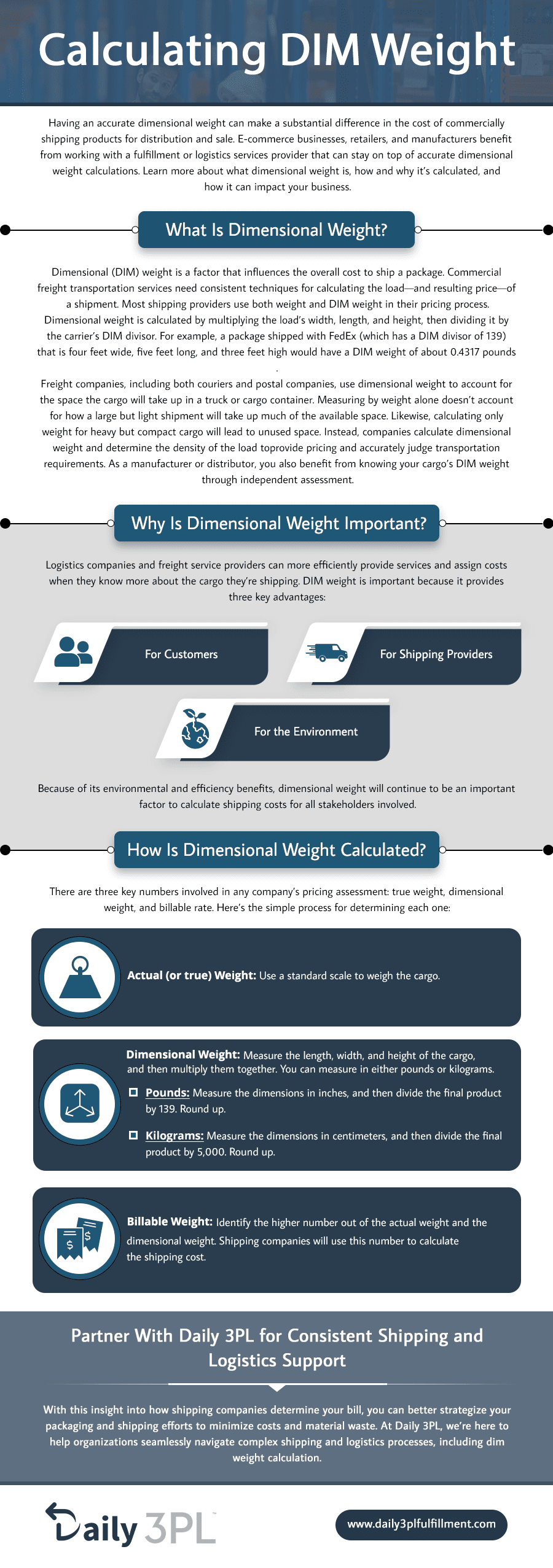Calculating DIM Weight
Leave a CommentHaving an accurate dimensional weight can make a substantial difference in the cost of commercially shipping products for distribution and sale. E-commerce businesses, retailers, and manufacturers benefit from working with a fulfillment or logistics services provider that can stay on top of accurate dimensional weight calculations. Learn more about what dimensional weight is, how and why it’s calculated, and how it can impact your business.
What Is Dimensional Weight?
Dimensional (DIM) weight is a factor that influences the overall cost to ship a package. Commercial freight transportation services need consistent techniques for calculating the load—and resulting price—of a shipment. Most shipping providers use both weight and DIM weight in their pricing process. Dimensional weight is calculated by multiplying the load’s width, length, and height, then dividing it by the carrier’s DIM divisor. For example, a package shipped with FedEx (which has a DIM divisor of 139) that is four feet wide, five feet long, and three feet high would have a DIM weight of about 0.4317 pounds.
Freight companies, including both couriers and postal companies, use dimensional weight to account for the space the cargo will take up in a truck or cargo container. Measuring by weight alone doesn’t account for how a large but light shipment will take up much of the available space. Likewise, calculating only weight for heavy but compact cargo will lead to unused space. Instead, companies calculate dimensional weight and determine the density of the load to provide pricing and accurately judge transportation requirements. As a manufacturer or distributor, you also benefit from knowing your cargo’s DIM weight through independent assessment.
Why Is Dimensional Weight Important?
Logistics companies and freight service providers can more efficiently provide services and assign costs when they know more about the cargo they’re shipping. DIM weight is important because it provides three key advantages:
- For customers: If a shipping company uses DIM weight to calculate shipping costs, you can save money by more efficiently packing your shipment. Efficient packaging reduces the dimensions of each unit, allowing you to fit more within a standard space.
- For shipping providers: Both true weight and DIM weight are necessary to calculate shipping costs, but the greater value is used in the actual billable amount. DIM weight pricing allows organizations to standardize pricing costs and operate more efficiently. This ensures greater customer satisfaction because it establishes consistent, competitive pricing and simplifies logistics management for large shipping organizations.
- For the environment: Calculating pricing according to DIM weight incentivizes efficient packaging, reducing overpacking and waste from excess foam, plastic, and cardboard materials. Shipping organizations can also use transport vehicles as efficiently as possible, reducing fuel consumption and lowering overall fuel emissions.
Because of its environmental and efficiency benefits, dimensional weight will continue to be an important factor to calculate shipping costs for all stakeholders involved.
How Is Dimensional Weight Calculated?
There are three key numbers involved in any company’s pricing assessment: true weight, dimensional weight, and billable rate. Here’s the simple process for determining each one:
- Actual (or true) weight: Use a standard scale to weigh the cargo.
- Dimensional weight: Measure the length, width, and height of the cargo, and then multiply them together. You can measure in either pounds or kilograms.
- Pounds: Measure the dimensions in inches, and then divide the final product by 139. Round up.
- Kilograms: Measure the dimensions in centimeters, and then divide the final product by 5,000. Round up.
- Billable weight: Identify the higher number out of the actual weight and the dimensional weight. Shipping companies will use this number to calculate the shipping cost.
Partner With Daily 3PL for Consistent Shipping and Logistics Support
With this insight into how shipping companies determine your bill, you can better strategize your packaging and shipping efforts to minimize costs and material waste. At Daily 3PL, we’re here to help organizations seamlessly navigate complex shipping and logistics processes, including dim weight calculation. Contact us today for more helpful insights or to learn more about our capabilities.

